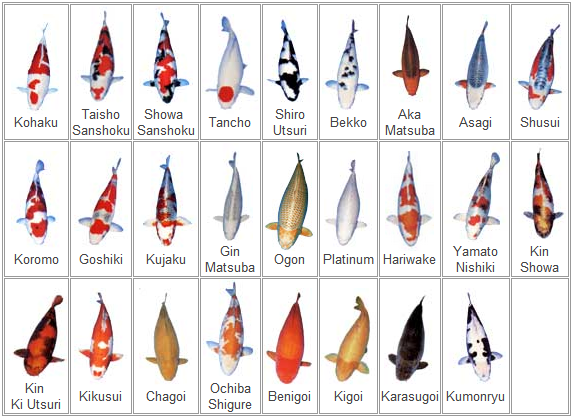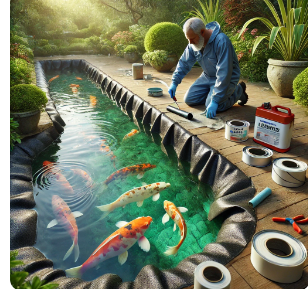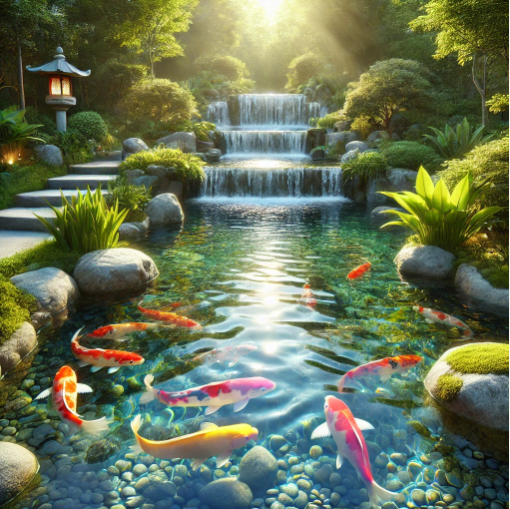Koi fish are some of the most beautiful and fascinating freshwater fish in the world. With their stunning colors, unique patterns, and rich history, koi have become a favorite for pond enthusiasts worldwide. But did you know there are dozens of koi varieties, each with its own distinct characteristics?
In this guide, we’ll cover the most popular types of koi fish, their unique features, and what makes them special.
1. Understanding Koi Varieties
Koi fish, also known as Nishikigoi, originated from Japan and have been selectively bred for their colors, patterns, and body shape. While all koi belong to the same species (Cyprinus carpio), they come in many different varieties, categorized based on color, pattern, and scale type.
2. The Major Categories of Koi Fish
Koi are divided into several main categories, with each group containing multiple varieties.
A. Gosanke – The Most Popular Koi
The Gosanke group includes the three most sought-after koi varieties in the world: Kohaku, Sanke, and Showa.
1. Kohaku (Red and White)
✔ Appearance: White body with red (hi) markings
✔ Significance: One of the oldest and most respected koi types
✔ Ideal for: Beginners and advanced koi keepers
🔹 Pro Tip: A good Kohaku should have a pure white body and deep, uniform red markings.
2. Taisho Sanke (White, Red, and Black)
✔ Appearance: White base with red and black markings
✔ Key Difference: Similar to Kohaku, but with black spots (sumi)
✔ Significance: Developed during the Taisho era in Japan
🔹 Pro Tip: The black markings should be evenly distributed for the best-quality Sanke koi.
3. Showa Sanshoku (Black, Red, and White)
✔ Appearance: Black base with red and white markings
✔ Key Difference: Showa koi have more black (sumi) than Sanke
✔ Ideal for: Koi enthusiasts looking for bold color contrast
🔹 Pro Tip: The black should appear on all parts of the body, including the head.
B. Metallic Koi Varieties
Metallic koi have a shiny, reflective appearance, making them stand out in any pond.
4. Ogon (Solid Metallic Koi)
✔ Appearance: One solid metallic color (gold, silver, platinum)
✔ Types: Yamabuki Ogon (gold), Platinum Ogon (white), and Hi Ogon (orange)
✔ Ideal for: Beginners due to their hardy nature
🔹 Pro Tip: The best Ogon koi have even coloration and a bright metallic sheen.
5. Hikarimoyo (Metallic Multi-Colored Koi)
✔ Appearance: Metallic koi with more than one color
✔ Examples: Ginrin Kohaku (shiny Kohaku), Kujaku (metallic with black net pattern)
✔ Ideal for: Those who love shimmering koi with complex patterns
🔹 Pro Tip: Look for strong metallic shine and crisp, clear patterns.
C. Unique Patterned Koi
These koi varieties have striking, artistic patterns that make them highly desirable.
6. Shusui (Scaleless Koi with Blue and Red)
✔ Appearance: Blue back with red or orange sides
✔ Key Difference: Unlike most koi, Shusui has no scales except along the dorsal line
✔ Origin: Created from crossbreeding Asagi and German mirror carp
🔹 Pro Tip: A good Shusui has a neat row of scales running down its back.
7. Asagi (Blue-Scaled Koi)
✔ Appearance: Light blue netted scales on the back with red on the belly
✔ Significance: One of the oldest koi varieties
✔ Ideal for: Koi keepers who love traditional patterns
🔹 Pro Tip: A symmetrical scale pattern makes an Asagi more valuable.
8. Tancho (Single Red Spot on Head)
✔ Appearance: White body with a single red circle on its head
✔ Key Difference: Resembles the Japanese flag, making it highly prized in Japan
✔ Ideal for: Koi competitions due to its unique simplicity
🔹 Pro Tip: The red spot should be perfectly round and centered.
D. Rare & Exotic Koi Varieties
For koi collectors looking for something different and eye-catching.
9. Doitsu Koi (Scaleless Koi)
✔ Appearance: Few or no scales, with a smooth body
✔ Types: Doitsu Kohaku, Doitsu Sanke, Doitsu Showa
✔ Ideal for: Those who love sleek and unique koi
🔹 Pro Tip: Doitsu koi should have clean skin and vibrant coloration.
10. Butterfly Koi (Long-Finned Koi)
✔ Appearance: Long, flowing fins with elegant movement
✔ Significance: A cross between koi and long-finned Indonesian carp
✔ Ideal for: Garden ponds and ornamental koi collections
🔹 Pro Tip: Longer fins and balanced proportions make Butterfly Koi more desirable.
11. Utsurimono (Black-Based Koi with White, Red, or Yellow)
✔ Appearance: Black base with white, red, or yellow patterns
✔ Types: Shiro Utsuri (black and white), Hi Utsuri (black and red), Ki Utsuri (black and yellow)
✔ Ideal for: Those who love bold, high-contrast koi
🔹 Pro Tip: A high-quality Utsurimono koi has deep, jet-black patterns.
12. Kikokuryu & Kin Kikokuryu (Black & Metallic Koi)
✔ Appearance: Metallic koi with a mix of black and white, sometimes with gold
✔ Key Difference: Kin Kikokuryu has golden highlights
✔ Ideal for: Those who love metallic and dark koi combinations
🔹 Pro Tip: A good Kikokuryu should have a strong metallic luster and crisp patterns.
3. Choosing the Right Koi for Your Pond
When selecting koi, consider: ✔ Pond size – Some koi grow over 30 inches
✔ Water conditions – Clean, well-filtered water keeps koi healthy
✔ Personal preference – Choose colors and patterns that you love
Final Thoughts
There are many types of koi fish, each with unique colors, patterns, and histories. Whether you prefer the classic Gosanke koi, metallic varieties, or rare exotic breeds, there’s a koi for everyone.
Key Takeaways:
✔ Gosanke (Kohaku, Sanke, Showa) are the most popular koi varieties
✔ Metallic koi (Ogon, Hikarimoyo) have a shiny, reflective appearance
✔ Patterned koi (Shusui, Asagi, Tancho) offer unique and artistic designs
✔ Exotic koi (Doitsu, Butterfly, Kikokuryu) stand out for their unusual features
By choosing high-quality koi and maintaining a healthy pond, you can enjoy these beautiful fish for decades.
📌 Which koi variety is your favorite? Let us know in the comments! 🐠💦




